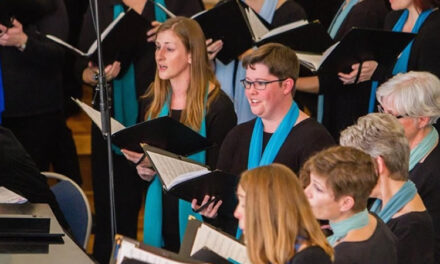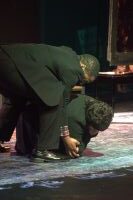Marc-André Hamelin certainly knows how to choose programs that showcase his strengths. The Canadian pianist has just about the most nimble and precise fingering in the business. But his program, the last of this year’s Raleigh Chamber Music Guild‘s Masters series, was more than a technical display. Hamelin’s restrained – even shy – stage presence belies an interpretive power of great subtlety and even wit. His program, consisting of Haydn’s Piano Sonata in B minor, Hob.XVI:32, Chopin’s Piano Sonata No. 3, also in B minor, and the Second Book of Préludes by Debussy, emphasized precision over passion.
The lack of personal flamboyance, however, suggests neither lesser musicianship nor lack of genuine feeling; it is simply that Hamelin does not wear his musical heart on his sleeve. The Haydn sonata, which reveals the influence of C.P.E. Bach’s Empfindsamer Stil (“emotional style”), uses pregnant pauses, spiky intervals and the minor mode to convey emotional intensity. It has built into it a kind of affective language which, to today’s listener, exposed over a lifetime to nineteenth and twentieth century Romanticism, seems rather quaint and quirky. Replete with elaborate ornamentation and sudden dynamic changes, the Sonata works best under the fingers of a classicist rather than a romantic. Gossamer-like pianissimos and sparkling trills and ornaments make this piece shine for contemporary audiences, and Hamelin certainly did not disappoint.
Hamelin applied his more introverted personality to the Chopin, a work that frequently suffers at the hands of overly passionate pianists with their elastic tempi and extreme dynamics. Hamelin’s interpretive approach was a refreshing step back from the febrile Chopinesque clichés that helped reveal the composer’s unusual harmonies. Here as well, the exacting execution of the rapid runs and ornaments was stunning.
The pièce de résistance of the program was the Debussy. The Préludes, each with a programmatic title that adds to the understanding of the musical imagery, are the descendants of the character pieces for harpsichord of the Baroque masters François Couperin and Jean-Philippe Rameau. Each of Debussy’s preludes is a substantial atmosphere-conjuring miniature, whose titles – if sometimes obscure – hold the key to their musical meaning. For example, in the first Prélude, “Brouillard” (“Fog”), Hamelin employed a stunning pianissimo with the sustaining pedal to render everything appropriately indistinct, with occasional fog-cutting interjections. In the next piece, “Feuilles mortes” (“Dead Leaves”), Debussy and Hamelin created a ponderous musical image, focusing on “dead” as opposed to “leaves.” Hamelin emphasized the humor in “Général Lavine – eccentrique” and “Hommage à S. Pickwick Esq.. P.P.M.P.C.” The long steady crescendo and Hamelin’s handling of Debussy’s irregular phrasing in “Feux d’artifices” (“Fireworks”) represented a prime example of Hamelin’s technical control and sensitivity to Debussy’s musical imagery.
Debussy’s characteristic rapid, shimmering accompaniment in counterpoint against a slower melodic line causes many performers to blur the distinction between melodic voice and its virtuosic accompaniment. Hamelin’s powerful technique is not just a matter of rapid execution; he controls the attack of each finger with the exactness that reveals the separate line of each voice.
After considerable prodding by the audience, Hamelin concluded the concert with a curious encore: his own transcription for the left hand of a Tchaikovsky lullaby.
The concert was sponsored by Zenph Studios, Inc., of Raleigh, a software technology company that has been working on recording digitally the precise sound from old analog recordings that can be “played” like a piano roll on a specially modified piano. Their latest venture, to be released by Sony BMG (on CD, not piano) later this month, is a reproduction of Glenn Gould’s famous 1955 recording of Bach’s Goldberg Variations. After intermission, John Walker of Zenph Studios demonstrated the results with the Aria and initial seven variations on an electronically modified Yamaha Disklavier Pro – the one on which Hamelin played as well. The piano “played” the digitally reconstructed performance, down to replicating the exact finger pressure and even the single wrong note. In contrast to the original mono, the reworking had precise intonation and no tape hiss, but it somehow took some of the intangible “life” out of the recording, perhaps in part because of the ghostly visual effect of the keys depressing themselves without the intervention of a pianist, perhaps because of the absolute, dead silence in the pauses between the variations. It was also a reminder that Gould’s interpretation, revolutionary as it was at the time, sounds a bit dated today.
PREVIEW: RCMG to Present Marc-André Hamelin — & Glenn Gould!
by Joseph Hartman
The Raleigh Chamber Music Guild will host yet another stellar concert to augment their already successful season on Tuesday, May 15, at the Fletcher Opera Theater in Raleigh. The featured artist will be pianist Marc-André Hamelin, who is returning to the Triangle after making an appearance in Durham last year. The French-Canadian virtuoso has taken the world by storm since his release of the Godowsky-Chopin Etudes in 2000, a recording that won the Gramophone Instrumental Award that same year. He champions the lesser known composers of the Romantic era as well as those of our own time. He is what one would call a pianist’s pianist or what CVNC Executive Editor John Lambert referred to as “a thinking person’s pianist” (April 19, 2006). This in no way infers that he is pedantic or dry; on the contrary, his performances are brilliant and insightful, with ample depth of emotion. It just so happens that his technique is among the most exceptional the world has ever seen.
Hamelin’s recital at Fletcher will consist of some staples of the repertoire rather than the less-than-usual fare we are accustomed to hearing from him. He will open with Haydn’s Sonata in b minor, H.XVI:32, which he also performs on his latest Hyperion disc of ten sonatas of the said composer. This particular one is typical of Haydn’s style, with colorful ornaments and ironic humor. The pianist will then move to Chopin’s Sonata No. 3 in B minor, Op. 58. This work is in some ways similar to the famous “Funeral March” Sonata, but is more refined and less bleak. For those who consider Chopin too feminine, pay close attention to the remarkably virile final movement. Hamelin will close the program with Claude Debussy’s Preludès (Deuxieme Livre). This volume, consisting of twelve preludes, scans the spectrum of Debussy’s music and will afford the listener an opportunity to see what the pianist can do with varying colors and moods. If you’re looking forward to hearing Hamelin bring forth his signature technical prowess, listen carefully to the “Feux d’artifice” (“Fireworks”) — the name says it all. Also interesting is the “Homage a S. Pickwick, Esq., P.P.M.P.C.,” which opens with a tongue-in-cheek quotation of “God Save the King.”
Another appealing note about the evening’s recital is that, following intermission, one of RCMG’s valued sponsors, Zenph Studios, will display their latest technological breakthrough. Let me preface my comments by telling the reader that I am in no way competent to explain how they have done what they have done, but I am quite sure the results will knock the socks off any piano aficionado. Patrons will be privileged to hear the aria and first seven of the Goldberg Variations of J.S. Bach as performed by Glenn Gould in his 1955 recording, remastered for “reperformance” by Zenph. The reading will be heard on a state-of -the-art Yamaha Disklavier Pro concert grand piano. Those who are technically deficient, like me, will want to know that this is a standard grand piano with high-tech, computer-driven components that permit it to “play” without a live performer. The March 6, 2007, press release from Sony states that the process of remastery has been so well done that the listener will feel as if he is sitting in the room with Glenn Gould. Every nuance and every pedal touch is recaptured in SACD/CD-quality sound. John Q. Walker, president of Zenph Studios, says of his creation, “We preserved every single note, including the mistakes. The improvements are all related to the sound quality. This is something that needs to be heard to be appreciated.” A CD of Gould’s complete performance of the Goldberg Variations will be available on the Sony BMG Masterworks label later this month.
Tuesday May 15
RCMG Masters Series; Marc-André Hamelin, piano*
Program: Haydn: Sonata in b minor, H.XVI:32; Chopin: Sonata No. 3 in b minor, Op. 58; & Debussy: Préludes (2ème livre) – Plus: Sponsor John Q. Walker, of Zenph Studios, introduces a Glenn Gould “re-performance” of the Aria and Variations 1-7 from the 1955 Columbia Lp of Bach’s Goldberg Variations.
Fletcher Opera Theater, Raleigh. 8:00 p.m.
$22, students $8. 919/821-2030 or http://www.rcmg.org/
*Sponsored by Zenph Studios, Inc.












